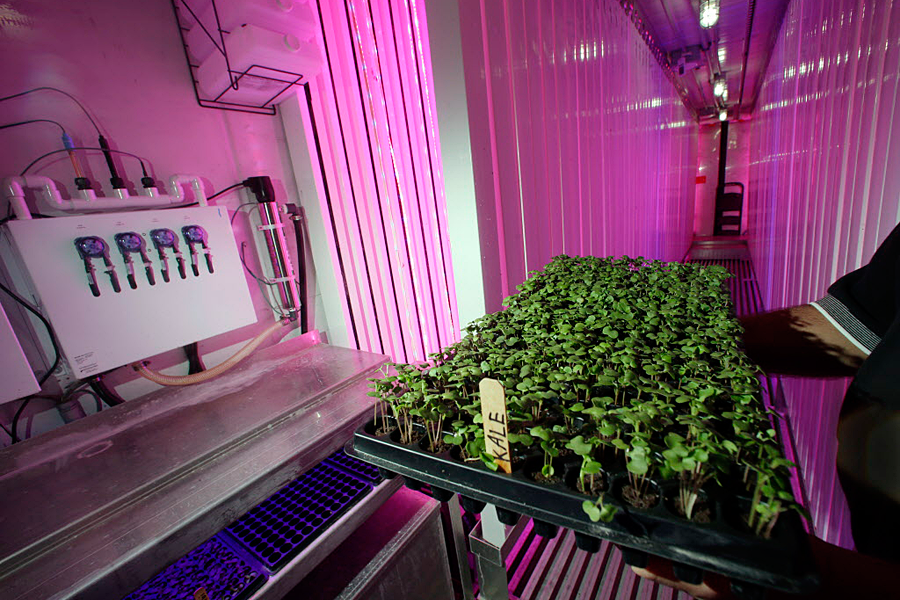Can you grow vegetables on a submarine? US Navy aims to find out.
When a Navy submarine first deploys to sea, it is stocked with fresh fruits and vegetables. A week in, the lettuce in the salad bar turns translucent, the tomatoes become mushier, and thawed fruit is common. Eventually, canned sauces and beans and dehydrated potatoes replace all fresh produce.
If research the US military has started is successful, a submarine crew’s diet won’t be bland much longer. The military has begun a $100,000 project to grow plants hydroponically – in a nutrient solution instead of soil – at the Army’s Natick Soldier Research, Development, and Engineering Center near Boston. Although the first two rounds of experiments have been on land in a 40-foot shipping container-turned-laboratory, the military hopes to one day grow plants inside the hull of a submarine.
The undertaking is just one of numerous projects aimed at to growing fruits and vegetables in the most unusual, even unnatural, environments to fuel manned journeys into the depths of Earth and space. As the military tries to perfect hydroponics in submarines, leafy greens and other vegetables are being grown in space and in the ocean in desalinated water.
Any progress made will benefit ocean and space explorers both physically and mentally, Erik Biksa, editor and co-founder of Grozine, a hydroponics magazine, tells The Christian Science Monitor in a phone interview Tuesday.
“If we take hydroponics with this, and it’s done properly,” says Mr. Biksa, about its application on submarines, “I think it could allow us to travel farther and be more comfortable, whether that’s underwater or above the atmosphere.”
Dan Holman, an engineering technician in the Navy overseeing the project, has already tried to grow 83 varieties of fruits and vegetables – some successfully, and others not. In the shipping-container laboratory, the plants are grown in trays of peat moss plugs, and transferred to towers suspended from overhead tracks, according to the Associated Press. Red and blue LED lights hang over the plants.
In the first round of tests, the leafy greens and green onions thrived. The cucumber vines, however, overtook the towers, the zucchini leaves blocked the light, and the tomato plants produced no fruit because the light was too dim and the temperature too cool.
Retired Navy Capt. Ronald Steed, a former submarine skipper, said the confined space in the inner hull of a vessel could limit how large a garden could be, and subsequently how much it could feed a crew of up to 170 on a ballistic-missile sub.
Yet, Biksa of Grozine says other hydroponic growers have learned how to turn a lack of space into an advantage by stacking plants vertically. He acknowledges a hydroponic garden can consume a large amount of electricity, but says LEDs require less electricity than conventional lights. When asked if the barometric pressure inside a submarine could affect plant growth, he says that if humans can handle the pressure, he expects plants can too.
These systems have already undergone testing in more extreme environments, including in space. Since 2002, the International Space Station (ISS), orbiting more than 200 miles above Earth, has hosted a greenhouse with plants grown through hydroponics, according to Garden Culture Magazine.
An ongoing experiment on the ISS is growing plants in a microgravity environment. In Veg-01, nicknamed Veggie, astronauts activated the seeds of red romaine lettuce in the production bay of the space station in rooting “pillows,” or chambers of clay, fertilizer, and water. About a month later, in August 2015, three American astronauts dined on lettuce grown aboard the space station.
“If we’re ever going to go to Mars someday, and we will, we’re going to need a spacecraft that is much more sustainable,” Scott Kelly, one of the astronauts, told The Guardian afterward. “Having the ability for us to grow our own food is a big step in that direction.”
Meanwhile, scuba divers are testing hydroponics in the ocean to feed not just ocean explorers, but the whole world. Nemo’s Garden, a project by Ocean Reef Group, an Italian-based scuba diving company collaborating with agricultural experts, has started to grow plants in pods submerged in saltwater more than a half-mile off the northwest coast of Italy. The water is desalinated before it reaches the plants.
“It could be a sustainable way of agriculture ... not just local businesses, but for large parts of the world,” Luca Gamberini, whose family has been running the Ocean Reef Group for six decades, told The Guardian.
This report contains material from the Associated Press.





